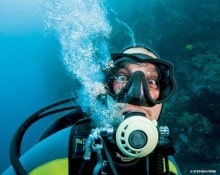Alternobaric vertigo is not uncommon in divers and pilots dealing with significant sudden change an ambient pressure. In fact, it has been documented in 14% of divers, and reported by 27 percent. Anyone who swims knows that you start to feel pressure in your ears just a few feet below the surface. Scuba divers know that you must “pop” your ears as you descend. The positive pressure of the water causes the air (gas) in the middle ear cavities to becomes increasingly negative by comparison the deeper you dive. This condition, which health professionals refer to as a retracted eardrum, is know in diver speak as a “reverse squeeze.”
When they equalize by popping their ears, one ear may clear, but the other may not, resulting in asymmetric middle ear pressure and vertigo. Consider that underwater the diver may have compromised visual cues, and tactile cues are missing. Even mild vertigo can be very disorienting and dangerous. Divers have the option of continuing to clear or “pop” their ears, or they can briefly ascend or descend (depending on which direction they are going) to reduce the pressure differential between ears. Once the pressure clears, the vertigo should subside, and there should be no recordable damage on vestibular testing.
In rare circumstances, this sudden pressure differential between the two middle ear cavities can be triggered by seemingly benign activities. There is a case report of a patient experiencing vertigo with a change in CPAP pressure. The hypothesis is that the positive air pressure (PAP) can move through the Eustachian tube on one side, but maybe not the other. This could result in asymmetry between the two middle ear cavities, affecting labyrinthine fluid dynamics on one side, resulting in vertigo.
Sometimes the pressure differential is so great, it can cause significant injury to the inner and/or middle ear, a condition known a barotrauma. More on that next week.
Click here for more information on alternobaric vertigo in divers.
Photo courtesy of Alert Diver Online







